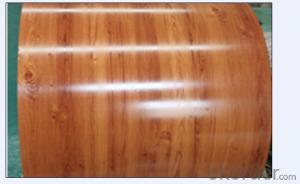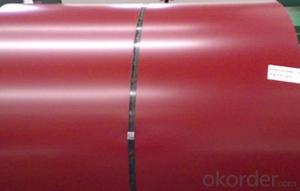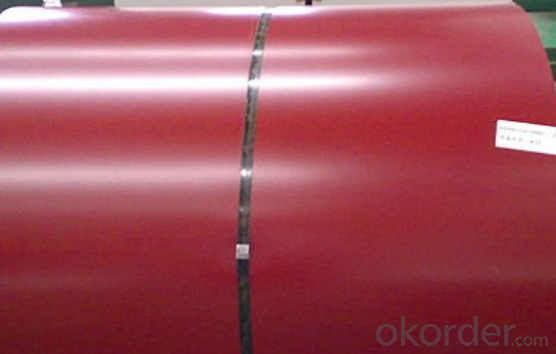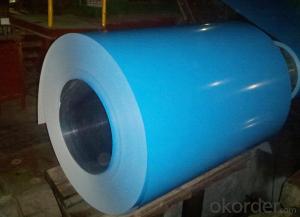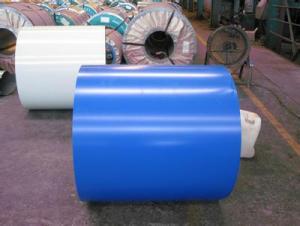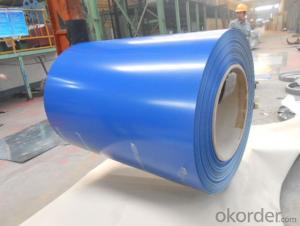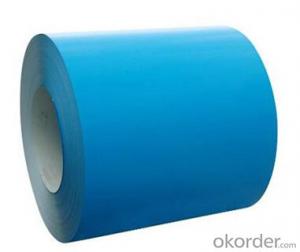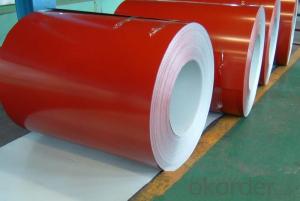Prepainted Galvanized steel Coil With Red Blue
- Loading Port:
- Tianjin
- Payment Terms:
- TT OR LC
- Min Order Qty:
- 25 m.t.
- Supply Capability:
- 100000 m.t./month
OKorder Service Pledge
OKorder Financial Service
You Might Also Like
1.Structure of Prepainted Galvanized steel Coil With Red Blue :
With Gi as base metal, after pretreatment (degrease and chemical treatment) and liquid dope with several Layers of color ,then after firing and cooling, finally the plate steel is called pre-painted galvanized steel ( PPGI) .Pre-painted galvanized steel is good capable of decoration ,molding ,corrosion resistance
Main Features of Prepainted Galvanized steel Coil:
• Excellent process capability
• Smooth and flat surface
• Workability, durability
• Excellent heat resistance performance
• High strength
• Good formability
• Good visual effect
2.Prepainted Galvanized steel Coil Images

3. Prepainted Galvanized steel Coil Specification
Standard:ASTM, GB,JIS,JIS G3302 ASTM 755 EN10169
Grade: DX51D CGCC CS
Thickness: 0.13mm~3.0mm,
Width: 1250,600-1250mm
Coil weight:3-12 MT
Coil ID:508/610mm
Chemical composition:
C | Si | Mn | Cr | Ni | P | S |
0.150 | 0.476 | 11.231 | 12.50 | 0.900 | 0.039 | 0.010
|
4.Application for Prepainted Galvanized steel Coil
Outdoor: sandwich panel roofing, roofing structure, surface of sheet of balcony ,frame of window ,door, door of garage, roller shutter door, booth ,cabana, refrigerated wagon and so on .
indoor: frame of door, light steel structure of house, sliding door, folding screen ,ceiling ,internal decoration of elevator
5.FAQ of Prepainted Galvanized steel Coil
We have organized several common questions for our clients,may help you sincerely:
1.How do you control your quality
We have established the international advanced quality management system,every link from raw material to final product we have strict quality test;We resolutely put an end to unqualified products flowing into the market. At the same time, we will provide necessary follow-up service assurance.
2.how long we will receive the goods ?
After receiving your deposit or workable lc ,our normal shipment date is 15-20days,and it takes around 28 days to reach your port of destination. But is up to different destination
3. what is your moq
Normally our moq is 25per size ,but it is up to different size
- Q: How does coil slitting work?
- Coil slitting is a process used in manufacturing industries to cut large coils of material, such as metal, into narrower strips of desired widths. The coil is unwound and passed through a set of circular blades that make precise cuts along the length of the coil. The blades can be adjusted to the desired width, and the process continues until the entire coil is slit into multiple smaller coils or strips.
- Q: What are the different methods of tempering steel coils?
- There are several different methods of tempering steel coils, each with its own advantages and disadvantages. Some of the most common methods include: 1. Air cooling: This is the simplest and most common method of tempering steel coils. The coils are heated to a specific temperature and then allowed to cool naturally in ambient air. This method is relatively quick and cost-effective, but it can result in uneven cooling and may not provide as precise control over the final properties of the steel. 2. Water quenching: In this method, the steel coils are heated and then rapidly cooled by immersing them in a bath of water. Water quenching provides a more rapid and controlled cooling rate than air cooling, resulting in greater hardness and strength. However, it can also lead to increased distortion and the formation of internal stresses in the steel. 3. Oil quenching: Similar to water quenching, oil quenching involves immersing the steel coils in a bath of oil to rapidly cool them. Oil quenching provides a slower and more uniform cooling rate compared to water quenching, resulting in reduced distortion and internal stresses. However, it also produces slightly lower hardness and strength compared to water quenching. 4. Salt bath quenching: This method involves immersing the steel coils in a heated bath of molten salt to rapidly cool them. Salt bath quenching provides an even and controlled cooling rate, resulting in improved hardness and strength compared to air or water quenching. However, it requires specialized equipment and may not be suitable for all types of steel. 5. Induction hardening: In this method, the steel coils are heated using an induction heating process and then rapidly cooled using either air, water, or oil quenching. Induction hardening allows for precise control over the heating and cooling process, resulting in specific hardness and strength properties in desired areas of the steel. However, it requires specialized equipment and is typically used for specific applications or parts of the steel coils. Overall, the choice of tempering method depends on various factors such as the desired properties of the steel coils, the type of steel being used, and the specific requirements of the end application.
- Q: i was thinking like getting a a steel building for 2 or 3 stall does anyone know how much that would cost? Have anyone used steel building how do you like them etc
- I have two steel barns, one is 4 stables. 15 x12 for 3 stables and the other 12 x 18 I have a large tackroom and an area for storing gardening and farm light machinery. (Chain saws. strimmers and fencing stuff.) The second barn has 4 stables 12 x 15. an 8' aisle and then two large loose shed areas. 30' x 50'. I can run these as one pen if I want. I have 45' x 70' at the other end for storing hay and straw. Haven't a clue to the cost but it wasn't cheap! Although it is all steel the lower walls of the stables are all blocks. I didn't want to line the steel with wood as they eat it for fun. The loose shed are lined with hard board.
- Q: If needed for Defence could a stainless steel sword kill someone my buddy wanted this sword for Defece after it is sharpend here is a picture
- Ya it could kill someone if it was sharpened enough but from experience stainless steel swords don't get as sharp as Carbon or higher grade steel. Not to mention it would probably bend if you hit someone with it all the way. Hell the one I let some people who were chopping a bush ( just a normal bush ) they were playing around and it got bent. I'm going to say I can't suggest a stainless steel sword for anything other then handing on your wall. Not even going into the whole If you use a sword for self defense is it considered self defense? debate. It's a sketchy situation not to mention you would need training with a sword to actually use it without it just getting brushed off.
- Q: What are the common surface defects found in steel coils?
- Steel coils can have several surface defects commonly found. One prevalent defect is rust or corrosion, which happens when moisture contacts the steel surface and causes oxidation and rust formation. Another defect is scratches or abrasions, occurring during coil handling or transportation. These can vary from small surface scratches to deeper gouges that affect the steel's structural integrity. Surface roughness or unevenness is also possible due to improper rolling or cooling processes during manufacturing, resulting in inconsistent surface texture that affects appearance and performance. Scale is another defect, forming an oxide layer during manufacturing, giving the steel a rough and uneven look. Finally, oil or grease stains may occur during manufacturing or handling, impacting paint or coating adhesion. These common surface defects impact steel quality, appearance, and performance, often requiring cleaning, grinding, or recoating as remedial actions.
- Q: How are steel coils used in the production of metal roofing?
- Steel coils are used in the production of metal roofing by being fed through a series of machines that shape, cut, and coat the steel to create the final roofing product. The coils are uncoiled and flattened, then formed into the desired profile using roll forming machines. The formed sheets are then cut into specific lengths and coated with protective layers to enhance durability and corrosion resistance. These coated steel sheets are then packaged and shipped to construction sites for installation as metal roofing.
- Q: How are steel coils used in the production of metal staircases?
- Steel coils play a vital role in manufacturing metal staircases. Typically made from high-quality carbon steel, these coils are initially uncoiled and then undergo a series of manufacturing processes to shape them into the required stair components. To begin the production process, specialized machinery is used to cut the steel coils into desired lengths. This allows for customized sizing to match the specific staircase design. Once cut, the coils are then shaped into various forms and profiles, such as stringers, treads, and risers, using bending, rolling, and stamping techniques. The use of steel coils offers several advantages in metal staircase production. Firstly, steel is renowned for its strength and durability, making it an ideal material choice for staircases that must bear heavy loads and endure frequent use. The flexibility of steel coils enables the creation of intricate and complex staircase designs, providing architects and designers with a wide array of options. Additionally, steel coils can be coated or finished in different ways to enhance their appearance and protect them from corrosion. This can include techniques like painting, powder coating, or the application of a protective layer such as galvanization. These finishes not only add aesthetic value to the metal staircases but also increase their longevity and resistance to wear and tear. In conclusion, steel coils are essential in the production of metal staircases as they provide the raw material that is shaped and formed into the necessary components. The strength, flexibility, and ability to be finished in various ways make steel coils a versatile and dependable choice for manufacturing durable and visually appealing staircases.
- Q: How are steel coils used in the production of automotive engine components?
- Steel coils are used in the production of automotive engine components by being processed and shaped into various parts, such as pistons, crankshafts, and connecting rods. The coils are first cut, stamped, and formed into the desired shapes, and then undergo heat treatment and other machining processes to enhance their strength and durability. These components are crucial for the proper functioning of an automotive engine, as they provide structural support and help convert the energy generated by the combustion process into mechanical motion.
- Q: hello, I am trying to figure out what wok to get and came across a website that offers many woks out of different materials. what is the best, or considered original (traditional)? I have a couple of cast iron pots and pans - too heavy, so I am assuming it will take some time for a cast iron wok to heat up. what about carbon steel and stainless steel? Thanks
- Best Wok To Buy
- Q: What is the market demand for steel coils?
- The market demand for steel coils is influenced by various factors such as construction, manufacturing, and infrastructure development. As steel coils are widely used in industries like automotive, construction, and appliances, the market demand for steel coils is generally high. However, it can fluctuate depending on economic conditions, industry trends, and global demand for steel products.
Send your message to us
Prepainted Galvanized steel Coil With Red Blue
- Loading Port:
- Tianjin
- Payment Terms:
- TT OR LC
- Min Order Qty:
- 25 m.t.
- Supply Capability:
- 100000 m.t./month
OKorder Service Pledge
OKorder Financial Service
Similar products
Hot products
Hot Searches
Related keywords
